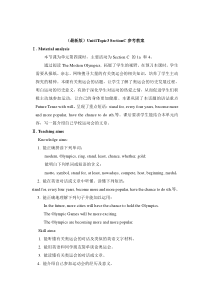 DOC
DOC
【文档说明】Unit 1 Topic 3《The school sports meet is cominga》(SectionC)教案-八年级上册英语【仁爱版】.doc,共(9)页,47.000 KB,由小喜鸽上传
转载请保留链接:https://www.ichengzhen.cn/view-104235.html
以下为本文档部分文字说明:
(最新版)Unit1Topic3SectionC参考教案Ⅰ.Materialanalysis本节课为单元第四课时,主要活动为SectionC的1a和4。通过阅读TheModernOlympics,拓展了学生的视野。在预习本课时,学生需要从报纸、杂志、网络搜寻大量的有关
奥运会的相关知识,培养了学生主动探究的精神。本课有关奥运会的话题,让学生了解了奥运会的历史发展过程,明白运动的历史意义,有助于深化学生对运动的热爱之情,从而促进学生们积极主动地参加运动,让自己的身体更加健康。本课巩固了本话题的语法重点Fut
ureTensewithwill,呈现了重点短语:standfor,everyfouryears,becomemoreandmorepopular,havethechancetodosth.等。课后要求学生能结合本单元内容,写一篇介绍自己学校运动会的文章。Ⅱ.TeachingaimsKnowl
edgeaims:1.能正确拼读下列单词:modern,Olympics,ring,stand,least,chance,whether,gold;能明白下列单词或短语的含义:motto,symbol,standfor,atleast,no
wadays,compete,host,beginning,medal.2.能在英语对话或文章中听懂、读懂下列短语:standfor,everyfouryears,becomemoreandmorepopular,havethechancetodos
th.等。3.能正确地理解下列句子并能加以运用:Inthefuture,morecitieswillhavethechancetoholdtheOlympics.TheOlympicGameswillbemoreexciting.TheOlymp
icsarebecomingmoreandmorepopular.Skillaims:1.能听懂有关奥运会的对话及类似的英语文字材料。2.能用英语和同学朋友简单谈论奥运会。3.能读懂有关奥运会的对话或文章。4.能介绍自己参加运动会的经
历及意义。Emotionalaims:发扬奥运精神,积极锻炼,强身健体。Ⅲ.ThekeypointsanddifficultpointsKeypoints:1.Inthefuture,morecitieswillha
ve…TheOlympicGameswillbemoreexciting.2.对everyfouryears,becomemoreandmorepopular,havethechancetodosth.等短语的理解及运用。Difficultpoints:理解下
列句子:Theyareheldeveryfouryears.TheWinterOlympicGamesareusuallyheldtwoyearsbeforetheSummerOlympicGames.Nowadays
,theOlympicGamesareheldbydifferentcitiesinturn.Ⅳ.Learningstrategies在预习本课时,学生从有获取其他资源信息的能力,发展到主动探究学习的能力。Ⅴ.TeachingaidsComputermulti
mediaprojector,flashofOlympicGamesEverydaysaying:Asoundmindisinasoundbody.健全的精神寓于健全的身体。Ⅵ.Teachingprocedur
esStepIntera1.Thewholeclasswork2.ThewholeclassworkctionpatternStudentactivity1.Focustheirattentionontheteacher.2.Studentssingwiththeflash.Teache
ractivity1.Greetstudentsreadyforlearning.2.Looktheflash“SongofHealth”sungbyFanXiaoxuan.Introduction(8minutes)3.Thew
holeclasswork4.Somestudents’work5.Thewholeclasswork6.Groupwork7.Thewholeclasswork3.Studentsshowtheirpaperstoothers.Thentheylookthroughothe
rs’information,tryingtounderstandsmuchaspossible.4.VolunteerswillintroducesomethingaboutOlympics.5.Studentsreadwiththeteacher
,thendiscussandcorrectpre-readingtask.Theyshouldfinishthepre-readingtaskbeforeclass.6.Avolunteergroupintroduceslikethis:
In2008,theOlympicGameswereheldbyBeijing.Theymayfindtheanswersin3onP22.7.Studentsunderstandthenewwordswiththeh
elpoftheirbackgroundknowledge,thepicturesandtheteacher’swords.3.AskthewholeclasstoshowtheinformationaboutOlympicstotheirpartners.Thenlookthroughth
einformation.Teacherwrites“Olympics”ontheblackboard.4.TeacheraskstwoorthreestudentstosaysomethingaboutOlympics.5.Teacherwrites“TheModernO
lympics”ontheblackboardandleadsthestudentstoread.Thenteacherletsstudentsfinishpre-readingtaskonP21.6.Teachercallsagrouptointrodu
cesomethingabouttheyearandtheplace.7.TeachershowstheOlympicmottoandtheOlympicrings,andteachesthenewwords“motto,ring,symbol”.
Presentation(12minutes)1.Thewholeclasswork2.Thewholeclasswork3.Groupwork4.Thewholeclasswork5.Thewholeclasswork6.Groupwork1.Students
finish1bbyusingtheirbackgroundknowledge.2.Studentsread1asilentlyandfinish1b.3.Avolunteergrouptells:(1)thefirs
t—start(2)hostcity—Athens(3)motto—FasterHigher,Stronger(4)symbol—Olympicrings(5)fiverings—standfor(6)theco
lorsoffiverings…(7)theWinterOlympicGames/theSummerOlympicGames—twoyearsbefore4.Allthestudentschecktheanswersintheirbooks.5.Studentstrytounders
tandthesentences.6.Studentsmakesentencesingroups:(1)WewillhavethechancetovisitAustralia.(2)Ourschoolsportsmeetwillbemoreexciting.(3)Thissongisb
ecomingmoreandmorepopular.1.Teacherasksthestudentstofinish1bbeforereading1a.2.Teacherasksthestudentstoread1aandto
check1b.3.Teacherletsthestudentscommunicatewithothersaboutthewaysinwhichtheyfindtheanswers.4.Teacherasksotherstudentstochecktheanswe
rs.5.Teachershowssomethingonthecomputerscreen:(1)Inthefuture,morecitieswillhavethechancetoholdtheOlympics.(2
)TheOlympicGameswillbemoreexciting.(3)TheOlympicsisbecomingmoreandmorepopular.6.Teacherasksthestudentstomakesentencesb
yimitatingtheexamples.Consolidation(10minutes)1.Thewholeclasswork2.Groupwork3.Thewholeclasswork4.Thewholeclasswork
5.Thewholeclasswork6.Thewholeclasswork7.Individualwork1.Studentsreadandunderlinewhattheydon’tunderstand.2.St
udentsreadingroupsandhelpeachothertoreadcorrectly.3.Studentslookandreadwiththeflash.4.Studentsunderlinethelanguagepo
intsinthebooksandtrytounderstand.5.Studentsreadandlookforsomethingtheydon’tunderstandyet.6.Studentslookthrough2firstandmakesuretheyk
nowwhattodo,andthenfinish2.7.Volunteersanswerandexplainthereason.1.Teacherasksthestudentstoread1aaloudindividually.2.Teac
herletsthestudentsreadingroups.3.TeacherplaystheflashofOlympicGames.4.Teachershowssomelanguagepointsont
hescreen.(1)…start/begin…(2)asymbolof…(3)standfor…(4)atleast(5)everyfouryears(6)…arebecomingmoreandmorepopular…(7)willhavechancetodosth.(
8)…willbemoreexciting5.Teacherasksthestudentstoread1athelasttime.6.Teacherasksthestudentstofinish2.7.Teacherchecksthestudents’answ
ers.Practice(5minutes)1.Thewholeclasswork2.Individualwork3.Groupwork4.Thewholeclasswork1.Studentsreadsilently.2.Volunteerssaysomething.3.Stud
entsfinish3andthinkaboutthereason.Agroupwillexplainthewaytodecidethekeys.4.Studentsreadaloud.1.Teacherasksthestudentstoread3.2.Te
acherasksthestudentstoaddsomethingaboutChinaintheOlympicGames.3.Teacherasksthestudentstofinish3andtotellthereason.take—tookwin—wonthe23rd
28goldmedalshosted—2008willwin—inthefuture4.Teacherasksthestudentstoread3aloud.Production(10minutes)1.Thewholec
lasswork2.Thewholeclasswork3.Thewholeclasswork4.Individualwork5.Thewholeclasswork6.Thewholeclasswork7.Individualwork1.Studentsth
inkandunderstandthequestionsin4.2.Studentsunderstandthestructure.3.Studentswritedowntheanswers.4.Volunteersreadtheiranswers.5.Studen
tsfinishwritingthepassage.6.StudentssummarizeSectionCwiththeteacherbydoingexercisesshownonthescreen.7.Studentsdothefollowingtasks:(1)Memorizethesumm
aryafterclass.(2)StudentsreviewSectionsA-CtoprepareforSectionD.(3)Studentswritethepassageafterclass,whichtheyh
avetoshowtoothersthenextlesson.1.Teacherasksthestudentsabouthowtodescribeathingandletsthestudentslookthrou
gh4.2.Teacherleadsthestudentstoformapassage:(1)time:when…(2)person:who…(3)what:thething…(4)significance:whatwecanlearn…from…3.Teacherasksthestudentst
oanswerthequestionsin4.4.Teacherchecksthestudents’answers.5.Teacherletsthestudentstoconnectalltheanswersto
gethertoformapassage.6.Teachershowsthesummarytothestudents:(1)Vocabulary.(2)thestructureoffuturetense.7.Teacher
assignshomework:(1)Reviewthesummaryafterclass.(2)ReadthroughSectionsA-C,andprepareforSectionD.(3)Writeaboutaschoolsp
ortsmeetthatyouoncetookpartin,finishing4onP22.TeachingReflectionIt’snothardforthestudentstofinish4afterlearn
ingthefuturetense.Theyareusedtowritingwiththefuturetensethisweek,buttherearestillsomemistakesintheiressays.Ⅶ.BlackboarddesignUnit1PlayingSportsTopi
c3Theschoolsportsmeetiscoming.SectionCInthefuture,morecitieswillhavethechancetoholdtheOlympics.TheOlympicGameswill
bemoreexciting.TheModernOlympicsTheOlympicsarebecomingmoreandmorepopular.mottoWhen/Whereshallwemeet?chanceLet’smakeithalfpas
tsix.beginningTheschoolsportsmeetiscoming.whetherPhrases:asymbolofstandforeveryfouryearsbecomemoreandmorepopularhavethechancetodosth.
 辽公网安备 21102102000191号
辽公网安备 21102102000191号
 营业执照
营业执照